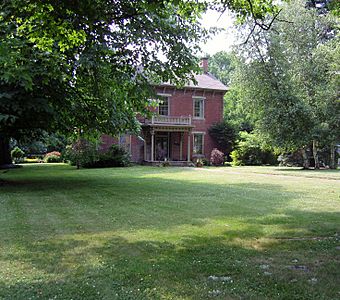John Street House facts for kids
Quick facts for kids |
|
|
John Street House
|
|

John Street House in summer
|
|
| Location | 631 N. Ellsworth Avenue Salem, Ohio |
|---|---|
| Built | 1838 |
| Architectural style | Italianate/Neoclassical |
| NRHP reference No. | 73001400 |
| Added to NRHP | October 10, 1973 |
The John Street House is a special old house in Salem, Ohio. It played an important role in helping people escape slavery long ago. This house was a secret stop on the Underground Railroad, a network of safe places for freedom seekers.
Contents
History of the John Street House
A Secret Path to Freedom
Long ago, in the 1800s, many people in the United States were enslaved. The Underground Railroad was not a real railroad. It was a secret system of safe houses and routes. It helped enslaved people travel north to freedom. Salem, Ohio, was a very important place on this secret path. Many safe houses were located there. The John Street House was one of them.
The Street Family's Role
The John Street House was built in 1838. It was the home of John Street. His father, Zadok Street, helped start the city of Salem. The Street family were Quakers. Quakers believed that all people should be free. They were very active in a group called the Western Anti-slavery Society. This group worked to end slavery.
The Street family wanted to help people escaping slavery. They changed their house to create secret hiding spots. They offered food and a safe place to sleep. In a hidden basement with no windows, freedom seekers could rest during the day. At night, they would travel to the next secret "station" on the Railroad. A tunnel connected this house to another safe house across the street.
Famous Visitors
A famous person named John Brown often visited the John Street House. John Brown was a strong supporter of ending slavery. He worked hard to help enslaved people gain their freedom. His visits show how important this house was to the anti-slavery movement.
Current Status of the House
Today, the John Street House is a private home. It is not open for public tours.
The house is recognized for its special design. It is listed on the National Register of Historic Places. This list includes buildings that are important to history or architecture.



